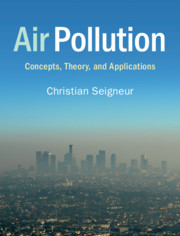Book contents
- Air Pollution
- Air Pollution
- Copyright page
- Contents
- Preface
- Main Notations
- 1 Brief History of Air Pollution
- 2 Emissions of Air Pollutants and Emission Control Technologies
- 3 Meteorology: General Circulation
- 4 Air Pollution Meteorology
- 5 Atmospheric Radiative Transfer and Visibility
- 6 Atmospheric Dispersion
- 7 The Stratospheric Ozone Layer
- 8 Gaseous Pollutants
- 9 Atmospheric Particles
- 10 Clouds and Acid Rain
- 11 Transfer of Pollutants between the Atmosphere and Surfaces
- 12 Health Effects
- 13 Environmental Impacts
- 14 Climate Change and Air Pollution
- 15 Regulations and Public Policies
- Index
- References
13 - Environmental Impacts
Published online by Cambridge University Press: 19 June 2019
- Air Pollution
- Air Pollution
- Copyright page
- Contents
- Preface
- Main Notations
- 1 Brief History of Air Pollution
- 2 Emissions of Air Pollutants and Emission Control Technologies
- 3 Meteorology: General Circulation
- 4 Air Pollution Meteorology
- 5 Atmospheric Radiative Transfer and Visibility
- 6 Atmospheric Dispersion
- 7 The Stratospheric Ozone Layer
- 8 Gaseous Pollutants
- 9 Atmospheric Particles
- 10 Clouds and Acid Rain
- 11 Transfer of Pollutants between the Atmosphere and Surfaces
- 12 Health Effects
- 13 Environmental Impacts
- 14 Climate Change and Air Pollution
- 15 Regulations and Public Policies
- Index
- References
Summary
Air pollutants may be transferred via dry and wet deposition to other media such as soil, surface waters, vegetation, and buildings. These pollutants may then contaminate these surfaces and have adverse impacts on ecosystems, vegetation, and the built environment. In addition, some chemical species that do not have any adverse health effects via inhalation may become toxic via bioaccumulation in the food chain and subsequent ingestion. This chapter describes briefly the impacts of air pollutant deposition on ecosystems, agricultural crops, and buildings, as well as the indirect adverse effects on human health via the food chain.
- Type
- Chapter
- Information
- Air PollutionConcepts, Theory, and Applications, pp. 304 - 317Publisher: Cambridge University PressPrint publication year: 2019

